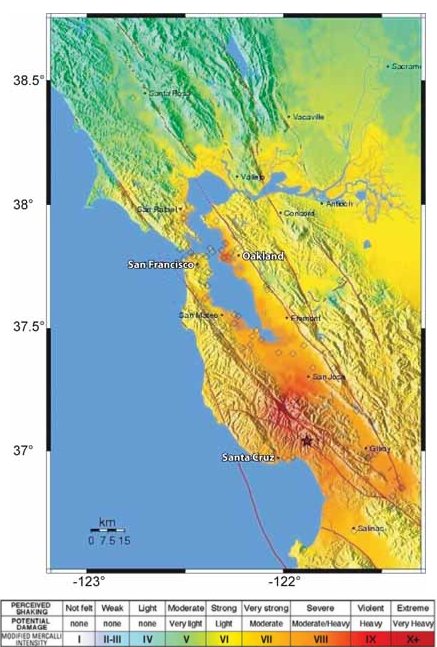| Date | October 17, 1989 |
|---|---|
| Origin time | 5:04:15 PDT |
| Duration | 8 – 15 seconds |
| Magnitude | 6.9 Mw |
| Depth | 19 km (12 mi) |
| Epicenter | 37.04°N 121.88°W |
| Type | Oblique slip |
| Areas affected | Central Coast (California) San Francisco Bay Area United States |
| Total damage | $5.6 – 6 billion |
| Max. intensity | IX (Violent) |
| Peak acceleration | .65g (at epicenter) |
| Tsunami | Yes |
| Landslides | 1,000 – 4,000 |
| Foreshocks | 5.3 ML June 27, 1988 5.4 ML August 8, 1989 |
| Casualties | 63 killed, 3,757 injured |
The 1989 Loma Prieta earthquake occurred in northern California on October 17 at 5:04 p.m. local time. The shock was centered in a sparsely populated area approximately 10 mi (16 km) northeast of Santa Cruz on a section of the San Andreas Fault System and was named for the nearby Loma Prieta peak in the Santa Cruz Mountains. With a maximum Mercalli intensity of IX (Violent), and a moment magnitude of 6.9, the shock was responsible for 63 deaths and 3,757 injuries in the affected areas. Damage was heavy in Santa Cruz County and less so to the south in Monterey County, but effects extended well to the north (and further from the epicenter) into the San Francisco Bay Area, both on the San Francisco Peninsula and across the bay in Oakland.
The Loma Prieta (or southern Santa Cruz Mountains) segment of the San Andreas Fault System had been undergoing a long period of quiescence until several moderate foreshocks occurred in June 1988 and again in August 1989. The foreshocks were of significance because that segment of the San Andreas Fault System had been so quiet that it had been labeled a seismic gap. No large earthquake had occurred in that region since the 1906 San Francisco earthquake. No surface faulting occurred, though a large number of other ground failures and landslides occurred, especially in the Summit area of the Santa Cruz Mountains. Liquefaction was also a significant issue, especially in the heavily damaged Marina District of San Francisco, but its effects were also seen in the East Bay, and near the shore of Monterey Bay, where a non-destructive tsunami was also observed. Abundant strong motion records were captured due to a large number of seismometers that were operating in the region.
Due to the sports coverage of the 1989 World Series, it became the first major earthquake in the United States that was broadcast live on national television. Rush-hour traffic on the Bay Area freeways was lighter than normal due to nearly 62,000 people present at the game at Candlestick Park in San Francisco, and this may have prevented a larger loss of life, as several of the Bay Area's major transportation structures suffered catastrophic failures. A section of the double-deck Nimitz Freeway that collapsed in Oakland was the site of the single largest number of casualties for the event, but the collapse of man-made structures and other related accidents contributed to casualties occurring in San Francisco, Los Altos, and Santa Cruz.








